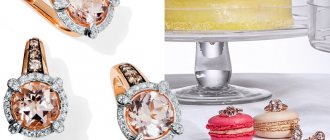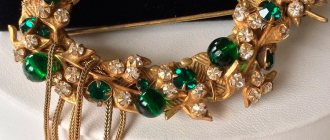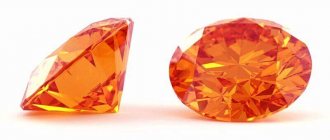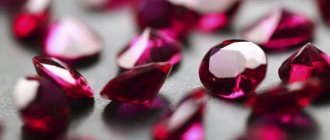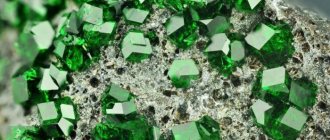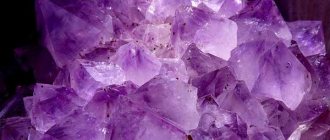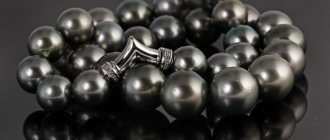In the previous publication we told you about the types and properties of yellow stones. And today we will share the information we have collected about pink stones, which so much attract the attention of girls. Thanks to their soft shade, gems evoke associations with kindness, romance, tenderness, and tranquility. The pink color of minerals in many cases is obtained from a mixture of white and red tones. Such a bright and unusual shade is associated with love and passion, while the stone is filled with innocence and lightness.
Almost all pink gems have been studied. Their value is determined by the unique characteristics of the breeds. Each stone has its own unique appearance, physical and chemical properties.
Types of pink stones
Types of pink stones are presented in all segments of the jewelry catalog - precious, semi-precious and decorative.
Precious
The smallest category of minerals. It contains stones, the pink variety of which is considered precious.
Diamond
How pink diamond is formed is still unclear to scientists. There are no impurities in it. It is believed that the pink tint is the result of “stress” suffered by the stone in the thickness of the earth.
Only one out of 10 thousand diamonds mined in the world is pink.
They are found in the Australian Argyle mine, each specimen is recorded.
You can only buy a gemstone at diamond exchanges or auctions at the Sotheby's level. Sometimes you have to wait in line for years.
Colored diamonds
Prices range from $100 thousand per carat, the cost of diamonds is in the tens of millions.
Kunzite
A rare mineral, kunzite, which has long been mistaken for lilac-pink amethyst. They are distinguished by the set of elements in the composition and the degree of gloss.
It is part of a group of gems that change color when viewed from different angles.
Jewelry with kunzite
The price is affordable – $50+ per carat.
Morganite
A variety of pink beryl is morganite, named after the American mineral lover and research sponsor J. Morgan. The delicate shade is created by a combination of cesium, lithium and manganese. However, when overheated or in bright sunlight, the crystals become discolored.
Ring with morganite
Sapphire
This type of corundum is created by chromium, vanadium and titanium. The more chromium, the more intense the pinkness.
This sapphire became fashionable after Prince Charles gave a ring with a pink stone to his bride, the future Princess Diana.
Ring with blue topaz and pink sapphire
This variety is cheaper than the blue one. The best private “pink” collections are at the royal houses of Great Britain, Norway, and Spain. There are many samples larger than five carats. Specimens twice as small are available for general trade.
The most expensive variety is the “warm” orange or yellow-pink Padparadscha sapphire.
Topaz
Pink topaz is the rarest and most expensive of topaz. The “imperial” variety is considered to be precious. It is amber, but thanks to the tint it appears pink.
Estimated at $350+ per carat.
Earrings with pink topaz
The Ural craftsmen discovered the recipe for turning gray stones into pink ones by baking them in bread.
Spinel
Spinel is a rare mineral of complex composition. The rose-colored hue is created by chrome.
Red-pink, especially of Afghan origin, is the most expensive of the spinels. The cost of a carat starts at $1000.
Pink and ruby spinel
Pink spinel from India is called "balas ruby".
Semi-precious
The segment also contains stones that have a pink primary color, and varieties of this shade of multi-colored minerals.
Agate
Pink agate is represented by the Bostwana agate variety. Named after the place of production (a country in Africa), identified by its gray-pink color.
Pink heart shaped stone
Amethyst
Pink or pink-violet amethyst is created by iron and manganese.
Gold pendant with amethyst
More such stones are mined than classic “violet” ones. They are inferior in price, but not in beauty.
Aniolite
A pink-green stone, a variety of the mineral zoisite. Essentially, a ruby is embedded in zoisite. Object of hunting for collectors.
Pearl
Natural pearls are considered precious. But it has not been mined since 1952, but is grown on special farms. Cultured pearls are classified as semi-precious, but in appearance they do not differ from natural ones.
Pearl beads
A pale pink set from the number one pearl brand Mikimoto is a status gift for ladies aged 25+.
Opal
Pink opal is the most romantic and delicate among opals. It is mined only in South America, for which it is nicknamed Andean or Peruvian opal.
Pink opal bracelet
Rhodolite
A pinkish-purple subspecies of pyrope garnet. It can be transparent or translucent. Purple shades are created by iron impurities.
Rubellite
A variety of pink tourmaline. Its name means "reddish" in Latin. Color plus shine against the backdrop of an affordable price ($20 per carat) made the semi-precious stone a popular substitute for an elite ruby.
Ornamental
The most democratic, popular group of minerals.
Coral
Pink corals (together with white ones) are considered the most expensive. Their color is heterogeneous, often “branches” interspersed with white or gray shades.
The best material for rose shades comes from the Mediterranean Sea.
Onyx
A variety of agate. Pinkish shades distinguish a subspecies called white onyx. The gem is opaque, matte, but looks gentle and sophisticated.
Rhodonite
It’s not without reason that rhodonite is called the “stone of dawn.” Monochrome copies look like this. There are also variegated varieties:
- Ribbon - with black-pinkish banding.
- Bustamite and its dendritic subspecies are red or black inclusions-“branches” on a grayish-pinkish background.
The stone is opaque, with a matte surface.
Bracelet with rhodonite
Rhodochrosite
Crimson spar, Inca rose – this is what rhodochrosite is called. The white-pink mineral is mined only in the USA; it is a stone from the state of Colorado.
Earrings with Rhodochrosite
The heritage of Russia is specimens of the color of ripe raspberries.
Story. Origin
Rubellite is a stone with an unusual fate. It is believed that it was known to people back in the Stone Age. Pink tourmaline was known in ancient times in Greece and Rome, but could not be distinguished from ruby.
In China, court dignitaries decorated their outfits with plates of this gem.
In the 18th century, scientists began to distinguish pink tourmaline from ruby. It turned out that many of the stones in the crowns and jewelry of the kings of Russia and the kings of the Czech Republic are not rubies, but rubellites. For example, a wonderful stone (255 carats) in the form of a bunch of grapes, donated by the Swedish king Gustav III to the Russian Empress Catherine II, turned out to be not a ruby, but a pink tourmaline.
Mistakes occurred well into the 20th century . Now researchers have clarified how to distinguish rubellite from ruby. Transparent tourmalines, including pink ones, are dichroic, meaning that when turned at an angle, two shades are visible. Ruby lacks this optical effect and has a pure red glow.
European scientists studied rubellite throughout the 18th century , and in 1794 the Irishman Richard Kirwan made a complete description of the physical properties of this stone.
Rubellite forms in pegmatites. There are other varieties of tourmaline nearby in the rock. The forms of this mineral are a collection of needle-columnar crystals, radiant druses, and sometimes single formations.
Methods of application
Where and how the pebble will be used depends on its physical, aesthetic conditions and value.
In jewelry, stones are framed in white shades:
- Diamonds, rubies, sapphires, spinel are awarded platinum, white gold 750°.
- Garnets, rubellites, and opals are framed in jewelry with 585° white gold; they look good in silver and cupronickel.
- Ornamental stones are framed in silver, jewelry alloy, cupronickel, or rhodium plating. It's actually costume jewelry.
It is not advisable to wear jewelry with large stones several at a time.
The ornamental group of minerals also serves as a material for small plastic items, inlaying boxes, photo frames, and other similar items.
How to care
Rhodonite does not have very high hardness, so it must be handled with care:
- Avoid falls and impacts.
- Protect from sunlight and water (especially sea water).
- You need to wash the stone in a soapy solution or clean water at room temperature (not in hot water). Use a soft brush or cloth.
It is believed that this mineral is capable of absorbing negative energy, so jewelry with it must sometimes be removed so that the stone and the owner can take a break from each other. You can rinse the pebbles with running water, but not for long.
Who are pink stones suitable for?
Rose-colored stones are considered the choice of romantic girls.
However, the wealth of shades allows ladies of any age and men to find an option:
- An ensemble of soft pinkish, medium-sized accessories will suit a mature lady.
- The younger the hostess, the more brightly the beads or inserts can sparkle.
- Inserts from Botswana, rhodochrosite, and ash-pinkish stones are appropriate in the men's assortment (cufflinks, ring).
Miniature earrings with a pink stone are a good gift for a little fashionista.
How to distinguish from a fake
Imitations of rhodonite are made of glass or plastic. You can distinguish them from natural stone by paying attention to the following parameters:
- Coloring. The stone has inclusions of other colors and shades, the pattern is chaotic. There are no patterns on glass and plastic or they are ordered.
- Weight. Stone is lighter than glass and especially plastic.
- Thermal conductivity. Natural stone does not immediately warm up in your hands, unlike fakes.
Magic properties
Esotericists have studied the magical properties of minerals of this range.
And they came to the conclusion: they add optimism, activate romantic feelings, help you find love, and arrange your personal life.
For example, pink topaz makes the owner younger and more attractive. For her, betrayal or loneliness are excluded. A ring or other talisman with this stone guarantees a man’s fidelity to his lover or wife.
Pink opal, Botswana agate is a proven love amulet.
They are also suitable for achieving more prosaic goals. Stones that are not particularly shiny, with a matte surface, are useful in finding your soul mate. Transparent crystals are needed by everyone who wants to awaken dormant talents and abilities and become creative.
Place of Birth
Rubellite is mined in different areas of the planet. In Brazil there are deposits of large purple-pink crystals - leaders in beauty and quality.
In Brazil, the weight of some drusen reaches four tons , and the length of the largest processes is almost one meter .
Rubellite found in:
- Mozambique;
- Namibia;
- Sri Lanka;
- India;
- USA;
- Germany;
- Italy;
- Czech Republic;
- in Madagascar.
In Russia, the Ural tourmaline mines are almost exhausted, but there are deposits in Transbaikalia and on the Kola Peninsula.
Therapeutic effect
The main healing mission of rose-colored gems is to heal mental illnesses, pathologies of the nervous system, and anxiety.
This is a good sedative that helps to recover from strenuous mental or physical work (especially rose quartz).
They have other functions too. For example, sapphire is suitable for people with heart and musculoskeletal problems. And also for a woman who dreams of becoming a mother.
Pink stones according to the Zodiac and dream books
Among the rose-colored stones there is an option for each zodiac sign:
- Aquarius. Sapphire, amethyst, topaz.
- Capricorn. Opal, onyx.
- Sagittarius. Topaz, spinel, sapphire.
- Twins. Agate, rhodochrosite, opal.
- Calf. Kunzite, onyx.
- A lion. Kunzite, spinel, topaz.
- Fish. Pearl, coral, sapphire, topaz, amethyst.
- Scales. Morganite, opal, rhodochrosite.
- Cancer. Quartz, pearls.
- Aries. Spinel, rhodonite.
- Scorpion. Amethyst, rhodochrosite.
- Virgo. Onyx, pearls, sapphire.
Dream books say: if you dreamed of a pinkish stone, you need to reconsider your attitude towards life and others. That is, take off your rose-colored glasses and become a pragmatist.
Such stones are also dreamed of if a person simply thinks a lot about buying them, jewelry, and an appropriate wardrobe.
almandine garnet
Among inexpensive stones, traditionally classified as semi-precious, there are also very spectacular and beautiful crimson stones, for example, garnets. These stones also come in many variations and color shades. Crimson and purple garnets are called almandines. They are often found in India and can be of vastly different quality. Small stones of mediocre quality are very cheap; they usually have many defects, cracks, and inclusions. Cheap stones are often too dark or pale in color, translucent or cloudy.
But large and pure almandines are unusually good. They are much cheaper than all other crimson-colored stones, they are more common, but they look no worse in products.

